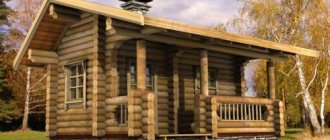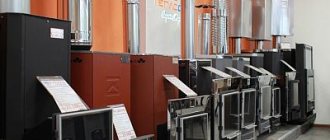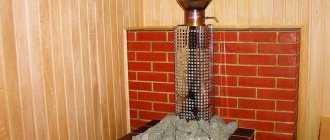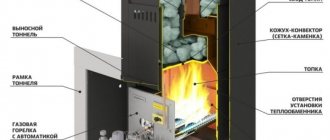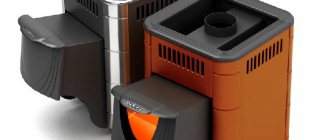Building a bathhouse and properly landscaping it is only half the battle. Correctly installing and choosing a stove is simple at first glance. Having made a mistake in calculations or not taking into account any factors, the bathhouse can turn into an unbearable ordeal, which will not only bring discomfort to the owners, but can be harmful to health. Which stove is best for a sauna, its types and their advantages will be discussed in this article.
Brick wood stove in a Russian bathhouse.
Types of sauna stoves
The heater of the stove, the steam or heat from it is an integral part of any bathhouse. It is difficult to say which pitch is better, since the range of offers on the market is off the charts. All heat generators for baths can be divided according to many characteristics.
Iron stove for a bath with an original mason in the form of a basket.
The first and main thing is the type of fuel the stove runs on. The main types are: gas, hard and liquid fuels, electricity. For a bathhouse, the following are best suited: firewood, electricity, gas. All of them are divided according to power, for a certain volume of space.
The next feature of a division is additional functions. There are stoves with steam generators, a combustion tunnel, a hot water tank, a fireplace door with heat-resistant glass, etc.
Finishing
- A wood-burning stove cannot be mounted to a wooden surface. Therefore, the podium on which it is installed and the wall behind it are protected by laying stones. This is an additional expense item.
- By default, finishing behind the electric furnace is not required.
| For certain models of electric furnaces, protection is necessary (powerful furnaces or open-casing furnaces). The exception is wall-mounted electric furnaces. There is no need to lay the wall behind them with stone, and this allows you to save on finishing. |
Gas stoves for baths
This is the rarest type of heat generator for a bath. A gas stove is simply expensive, and its installation requires special permission and individual design. Nobody likes to waste their time and money, so it is easier to install any other type of stove.
The undeniable advantages of gas stoves:
- Quick heating of the steam room.
- Automatic temperature control.
- There is no need to periodically clean the ash pit.
- It is heated without constant fuel loading.
Varieties
According to the design, method of connecting or disconnecting any type of fuel, there are three types of gas-wood stoves:
- Convertible. The design is a classic gas stove made of cast iron, which comes complete with an additional chamber for solid fuel and a mounted heater. If desired, you can easily turn off the gas supply, install a firebox with a heater and use firewood.
- Paired. A massive device that consists of two modules. One of them runs on gas, the other on wood. The parts are combined by one heater. Another design feature is the presence of two separate chimneys.
- Monoblock. This is a one-piece design with only one combustion chamber for different types of fuel. To use gas or firewood, you need to turn special valves. They divide the firebox into two parts and the design is universal.
Depending on the location of the water tank, there are 3 types of structures:
- Built-in tank. The water container is made of stainless steel. When wood burns, liquid and stones are simultaneously heated. Due to the fact that the tank is built-in, it is limited in size.
- The tank is fixed to the chimney. The gases that pass up the pipe transfer their heat to the liquid. The maximum volume of the mounted tank is 75 liters.
- A container of water is installed next to the equipment. Heating of the liquid occurs due to heat transfer through the coil. In this case, the tank can be placed in any convenient place.
A separate division relates to the location of the firebox. It can be built-in or remote.
The water tank is fixed next to the stove
Wood-burning stoves for saunas
Designer wood-burning stove in the steam room with a tunnel from the dressing room.
Wood-burning heaters are a traditional type of stove for Russian baths. Our ancestors used them, and there is no better recommendation than the test of time. Wood-burning stoves can be made of alloy (metal, cast iron) or brick.
The main advantage of a wood-burning heater made from brick is that it retains heat for a long time. And the heat emanating from red brick coated with clay is soft and uniform, which cannot be said about metal alloys.
A similar design solution can be seen in the photo on the right.
The main disadvantages of a stone stove:
- The structure is heavy, so the foundation for it needs to be solid.
- It takes a long time to heat up.
- Needs to be cleaned constantly.
- It is difficult to find a specialist who can lay out a brick heat generator correctly.
A metal wood stove is more expensive, but you can buy it at any specialized chain. The main advantages of an iron structure: ease of installation, lightweight foundation, heats up quickly, ease of maintenance and good steam quality. In addition, modern designs have a beautiful appearance and will become a real highlight of any bathhouse.
It is good if alloyed steel with 12% addition of chromium was used for manufacturing. Otherwise, the iron quickly burns out and the service life is no more than 3-4 years. The most resistant and durable material is cast iron. Cast iron stoves will last more than 50 years. But the weight of the structure will increase. Compared to brick, a cast iron stove is lighter. The temperature of a cast iron stove also lasts longer. The metal one cools down very quickly, so it needs to be constantly heated.
Design and principle of operation
To understand how the device works, you need to understand its structure. The equipment consists of several elements:
- gas burner;
- solid fuel combustion chambers;
- chimney;
- grate;
- heat exchanger;
- heaters;
- convector casing.
First, a person decides what he will use to heat the bathhouse. Having made a choice, he must either load the combustion chamber with firewood or light the gas burner. When any type of fuel burns, stones heat up, from which you can get steam for bathing procedures.
Electric sauna stoves
Electric sauna stove of a new generation with a heater on top.
Electric stoves have been used more and more often in private homes lately. Previously, this was hampered by the high price of electricity, but the cost of firewood has increased during this time and consumption has almost become equal. The main advantages of an electric heat generator: ease of installation, temperature control, fast heating, ease of maintenance.
There is an opinion about the high electromagnetic radiation of the heater, but there is no reliable information on this issue. It’s just that similar studies have not been carried out, as well as how much oxygen an electric heater burns. And at a frequency of 50 Hz, aggressive electromagnetic radiation cannot occur - this is information from a physics textbook for the 8th grade.
The main disadvantage of an electric steam room is that it is not always possible to supply water to such a heater. But using it in bathhouses where the steam room is combined with a washing room is simply dangerous.
Reviews
Of course, we are all tired of advertising and want information that comes directly from users. But it has long been the subject of falsification, so let’s proceed from common sense: in general, reviews of the electric heater will be positive from those who received exactly what they wanted - either a sauna stove, or that rare variety that allows you to arrange a sauna “in Russians." And if you want more detailed information, take a look at the articles that are devoted to specific models, where reviews will concern both real advantages and real disadvantages.
What criteria should be used to compare different stove designs?
The most important parameters of a heat generator for a bath are:
- The quality of the steam produced.
- The presence of a combustion tunnel and its dimensions.
- Convector heat exchange.
- Power for a specific steam room.
Let's look at each in more detail.
Quality of steam produced
Steam in the steam room should be supplied at a temperature no higher than 90 degrees.
It’s not for nothing that when we go to the bathhouse, our loved ones wish us “light steam.” Light steam is considered the best and healthiest. This is steam with a minimum amount of moisture. With this, blood pressure does not change and high temperatures are easily tolerated.
The structure of “light steam” is finely dispersed, which can only be obtained by heating the stones to +350 +500 °C. But you cannot heat the stones to such a temperature, otherwise the temperature in the steam room will be above 110 °C, and steaming with a soaked broom can simply get you burned.
To generate “light steam”, ovens are equipped with special steam generators. Many people confuse it with steam generators, which produce heavy steam from boiling water. The steam generator is located in the structure on the side of the firebox. The temperature in the steam generator rises faster than in the heater, and the first water supply is carried out there.
Presence of a combustion tunnel
The combustion tunnel is placed only in high-quality furnace designs. Its presence is due to several reasons:
- During combustion, most of the oxygen is processed. And the steam room where the stove is located, as a rule, is not large. It is better if oxygen is taken from another part of the bath.
- The combustion channel makes it possible not to bring excess dirt, for example from firewood, into the steam room.
- Placed in the combustion tunnel of a heat-resistant glass door, it allows vacationers to relax and unwind while watching a live flame. In cheaper designs, the door is solid.
Convector heat exchange
Stove of the Russian manufacturer Ermak with convector.
The presence of a convector in the oven creates constant movement of air masses. By constantly mixing, the air throughout the steam room warms up evenly. With a convector, there will never be a situation where your feet cool down in the bath and your head overheats.
A steam room with a convector warms up faster, so you can heat a room with a volume of 25 m³ in 40 minutes.
A correctly chosen sauna stove always has a convector in its design. The convector looks like the gap between a hot flame and a heater.
Power for a specific steam room
Choosing the right furnace wattage is just as important as the furnace itself. To make the correct calculation, it is enough to know the basics of heat engineering and mathematics. But not every busy person is able to make calculations correctly. Responsible manufacturers have taken care of their customers and provide ready-made tables for each line of models. All you have to do is choose the right one.
We have already discussed how to correctly calculate the power of the stove and the volume of the steam room in the article about wood-burning stoves for saunas.
Ease of use
An electric oven is easier to use and opens up additional possibilities: it can set the temperature with an accuracy of a degree, and regulate the humidity if an evaporator is installed. The devices have two types of control: knob-switch or panel. For some models, you can use an Internet module (its cost is about 100 thousand rubles). Then the oven will be turned on remotely via a smartphone. Another function is the turn-on delay. For example, if the owner of a bathhouse leaves home for several hours, he can choose a delay, and the stove will begin to heat up only upon his arrival.
So gas, or is it wood?
A gas stove for a bath, lined with stone-like ceramic tiles, looks original in a Russian bath.
The answer to the question which stove is best for a bathhouse depends on many factors: the size of your wallet, capabilities and the availability of communications on the site. So, if a gas system is connected to the dacha, it is better to build a red brick stove and place a nozzle inside for burning fuel. The brick will warm up evenly, and you can wash in such a bath even the next day.
A wood stove is suitable for those who don’t mind chopping wood every time and going to add it every 30-40 minutes. Also, solid fuel is suitable for lovers of the Russian traditional bath.
For those who save their time and do not want to clean the stove and remove the ash, the electric option is better. Among other things, such modern stoves are equipped with a timer and temperature regulator; the stove will light itself, just set the time.
You should not buy a stove from an unknown manufacturer. This option is comparable to buying a lottery ticket, which is 70% unsuccessful.
Which stove you need can be calculated by knowing the size of the steam room and other features of a particular bath; the rest depends on personal desires and the amount of money that the buyer is willing to spend.
General issues
Life time
Among wood-burning stoves, cast iron ones are the most durable, but it is very important to observe the combustion mode and not overheat the stove, since cast iron can burst due to overheating, after which the stove is most likely beyond repair. Overheating of steel furnaces is also dangerous, which leads to deformation of panels and rupture of welds. The thickness of the slab above the firebox does not always directly reflect the intended working life of the steel furnace, but we can definitely say that frequent overheating will also lead to faster burnout of the slab.
The service life of gas furnaces largely depends on the quality of individual components and elements. With proper quality, the operation of a gas furnace can be very long.
The service life of electric stoves is approximately 10 years, but it must be taken into account that they are designed for different intensity of use: from a private, home sauna with 2-3 steam sessions per week to a public commercial sauna with many hours of daily loads.
Fire safety
Fire safety assessment is largely subjective and often based on personal negative experience. It is traditionally believed that a wood stove is the most dangerous in this regard. But in order to minimize risks, it is enough to fulfill all the necessary fire safety requirements when building a bathhouse, regularly clean the chimney, and be careful when using the stove. A gas furnace can pose no less a danger if the installation and connection were not carried out in good faith, low-quality materials were used and a gas leak occurs. Using a gas cylinder is an even greater risk factor. The same applies to electric furnaces: a fire due to a short circuit is very likely if the power line wiring is careless, the cross-section of the wire does not correspond to the load, there is no flammable cable protection or used, etc.
Operating rules
When operating combined heating equipment, a number of rules must be observed:
- It is prohibited to allow small children near the stove.
- Do not turn on the gas burner if any elements are faulty.
- After finishing the bath procedures, you need to check the gas taps. There is no need to overlap them.
- We must not forget to regularly clean the chimney and combustion chamber from soot and ash.
- It is forbidden to douse the flame in the firebox with water.
- You can use liquefied gas, natural gas or any type of firewood.
Gas-burning stoves have gained great popularity due to the ability to use different types of fuel to heat bath rooms. A complex device requires precision installation work and consideration of operating features, but the result will please you with its efficiency and versatility.
30.11.2020
Manufacturers and prices
Furnace models:
- Teplodar Rus 12 LSDU. Compact design for heating rooms with a volume of no more than 12 cubic meters. The heater holds 50 kg of minerals. The door is self-cooling.
- Termofor Urengoy 12. The main advantages of the model are its attractive appearance and efficiency.
- Furnace Ermak Uralochka 20T. Suitable for heating rooms with a volume of no more than 13 cubic meters. The heater can hold up to 40 kg of stones. The stove does not take up much space.
- Teplodar Rus 18 LSDU. Powerful furnace equipment can heat rooms with a volume of up to 18 cubic meters. Has no sharp corners. The average price for gas wood stoves is 15,000 rubles.

